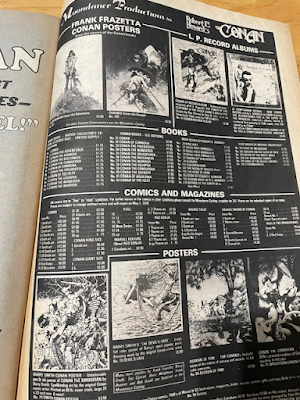I haven’t bought a new comic book in 33 years, when I purchased the April 1991 Savage Sword of Conan as a high school senior. The venerable magazine ended its long run four years later. I was in college in these waning days of SSOC and so had no spending money for comics; what little funds I had went toward beer.
I've purchased a handful of back issues of SSOC since, but that’s it. And had no intention of ever buying a new comic again … until now. The hype around the relaunch of SSOC by Titan Comics piqued my interest and I decided to give it a go.
Before I get to the contents I have to say the packaging/mailing is a 10/10. I have never ordered a comic book by mail and dreaded it would arrive mangled by the postal service, but it was secured with cardboard backing in a plastic sheath and packaged in a rigid cardboard flat. The magazine arrived in wonderful shape.
I opened it up and immediately thought, this is what I wanted it to be.
Black and white interior art on newsprint pages, just like the old magazine. Savage and sexy with beheadings and nudity. Pinup art, text articles. The cover callback to the classic Frazetta Conan the Adventurer, featuring Conan astride a mound of corpses with a woman clutching his knee. A shot of nostalgia.
It checked all the boxes.
Yes, it has some well-documented issues with the art being too dark. Not every panel, and the Solomon Kane story does not suffer from this problem. The Hyborian Age map suffers the most, as does a pinup image of Belit. Equally annoying was the lack of page numbers; there is a TOC with page numbers cited but no corresponding numbers on the pages themselves. These were either forgotten or cut off during the printing.
I’m sure these glitches will be fixed.
On to the contents.
I loved opening the issue and seeing an introduction by the legendary Roy Thomas. As if the iconic cover drawn by SSOC veteran Joe Jusko wasn’t enough, Thomas’ recap of the magazine’s history was a perfect way to kick off the issue. Thomas also alluded to having “a story or three” planned for future issues, which would be a very welcome development.
I enjoyed the main feature, “Conan and the Dragon Horde” by writer John Arcudi and artist Man von Fafner. I appreciated it being self-contained to the issue, a big plus for me. The story kept me interested, with enough twists and turns and no lulls. Conan was well-drawn, especially his savage facial expressions. It features a couple well-done “boss fights” with dragon-like dinosaurs and two hulking bodyguards, and a necropolis. The story is quite gritty and has no overt sorcery, even the monsters could be atavistic survivors of a pre-Hyborian/prehistoric age. I perhaps raised an eyebrow at the accuracy of the siege engines (they accurately target moving people, one is used to drop a noose around a man in a melee?) but otherwise was on board with what I was reading.
That said I thought the second-tier Solomon Kane story “Master of the Hunt” was even better. A historical curse laid on a medieval Welsh Lord gives rise to a vengeful demon, and the horror atmosphere is palpable (it reminded me a bit of the beginning of An American Werewolf in London—keep off the moors!). The story ends on a cliffhanger which makes issue #2 a must-buy. The art in this story was perfectly clear and non-murky, and it’s good. Kane is well-rendered.
I’m not sure why the need for the prose Jim Zub story “Sacrifice in the Sand,” other than it pairs with the cover. I would have preferred to see a photo essay like we had in the old SSOC days, perhaps a recap of Howard Days or the like. I hope Titan brings those back. Zub did a nice job writing this short two-pager, and I found his prose atmospheric and poetic. It could have made for a nice 6-8 page illustrated short.
I enjoyed Jeff Shanks’ Solomon Kane essay, which paired well with the story. Shanks is a first-rate Howard scholar whom I met at last year’s Howard Days. His “Hyborian Age Archeology” is a must-read, and I relied upon and cited his essay “History, Horror, and Heroic Fantasy: Robert E. Howard and the Creation of Sword and Sorcery” in Flame and Crimson. In comparison to his academic work this Kane essay is sleight, but that’s what you’d expect in a comic magazine. I found it to be a good overview for a new reader of Kane’s publishing history and the character himself.
Oh and REH himself makes an appearance with a reprint of his poem "The Road of Kings."
I thought the riskiest move was the dead horse on the cover; these days people seem OK with every manner of violence inflicted on humans but revolt at the sight of dead animals. Unfortunately corpses of horses littered the battlefields of every historical engagement, well into the 20th century. I have no problem with it, I’m sure some will.
Overall I’m quite happy with issue #1. If you’re a Conan fan you should be too. SSOC is back.














